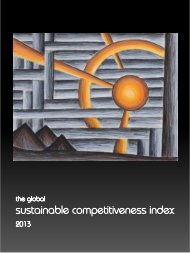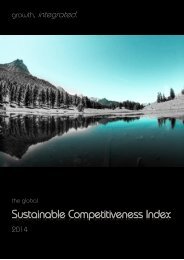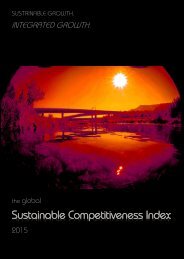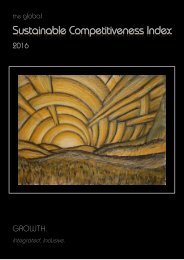The Global Sustainable Competitiveness Index 2019
Measuring competitiveness comprehensively: Sweden & Scandinavia tops, Germany #15, UK 17, US 34, China 37 in the Global Sustainable COmpetitiveness Index 2019
Measuring competitiveness comprehensively:
Sweden & Scandinavia tops, Germany #15, UK 17, US 34, China 37 in the Global Sustainable COmpetitiveness Index 2019
Create successful ePaper yourself
Turn your PDF publications into a flip-book with our unique Google optimized e-Paper software.
Natural Capital
Table of
Contents
Natural Capital Components
The Natural Capital of a country is defined by the natural physical environment.
The Natural Capital model incorporates the essence of resources available that
allow a country to be completely self-sustaining: land, water, climate,
biodiversity, food production and capacity, as well as renewable and nonrenewable
energy and mineral resources. In addition, the level of depletion or
degradation of those resources that could endanger future self-sufficiency are
taken into account to reflect the full picture of the available natural capital.
The number of data points related to natural capital available from a variety of
sources is nearly endless. The main challenge is to select the most relevant and
meaningful indicators amongst the wealth of available data. In order to define
meaningful and relevant, the core issues affecting the sustainable use of natural
capital have been defined in the natural capital model below:
Key elements of
competitiveness drivers in the
Natural Capital Sub-Index
Natural capital indicators
Based on the definition of the key natural capital areas, data series are chosen
as indicators that reflect the sustainable competitiveness of a country based on
its natural resources (natural capital).
The indicators have been analysed for the latest data point available as well as
their development over time, reflecting the current status and the future outlook
in relation to the size and population of a country. In addition, indictors that
measure the depletion or degradation of the natural resources have been taken
into account. The combination of these indicators reflect the current status as
well as the ability to sustain the population and the national economy.
As some of the above key areas are difficult to express in numerical values, some
quantitative scores compiled by UN agencies have been used for certain
indicators, such as biodiversity potential, resource depletion, and the ecological
footprint.
For the full list of indicators used, please refer to the methodology section.
13








